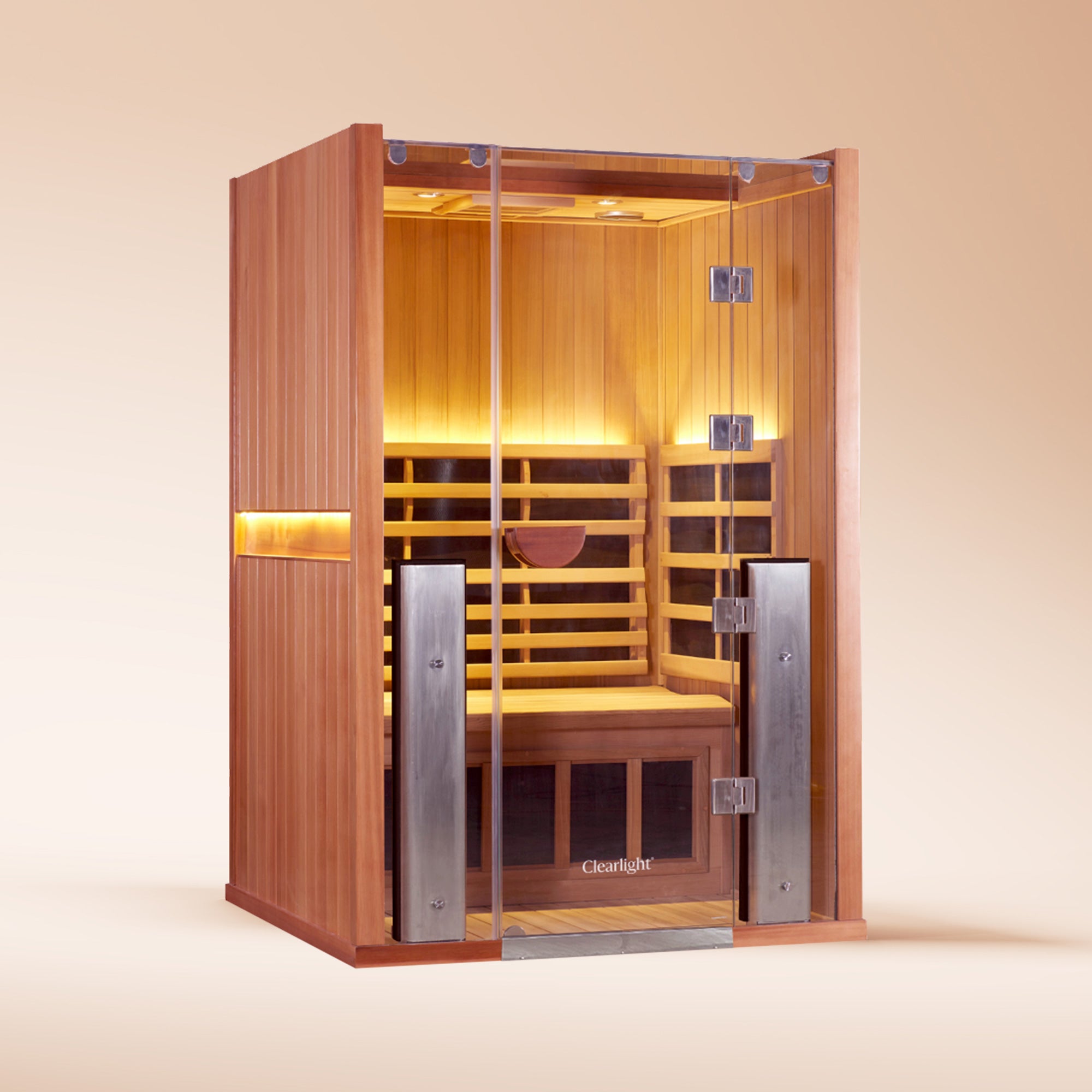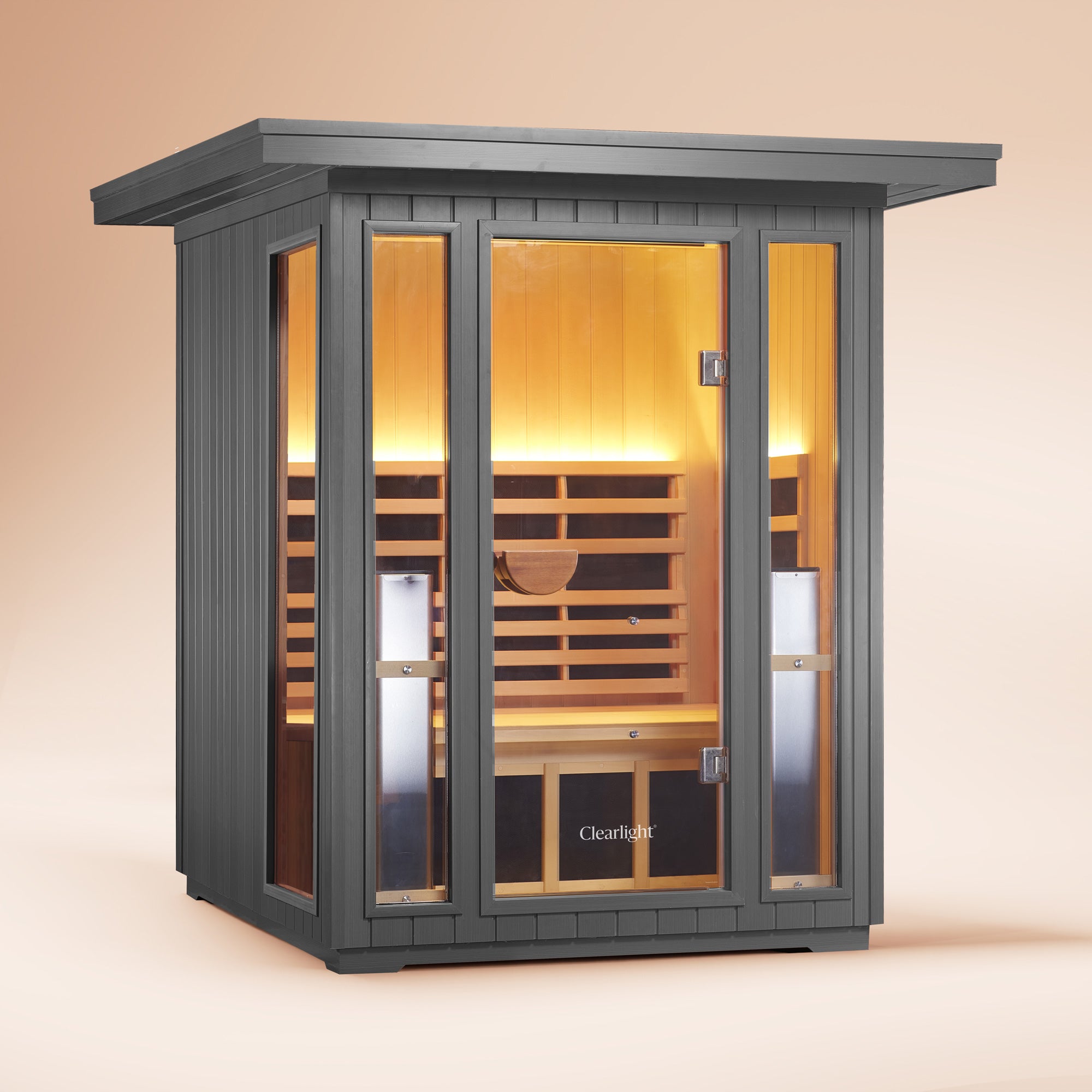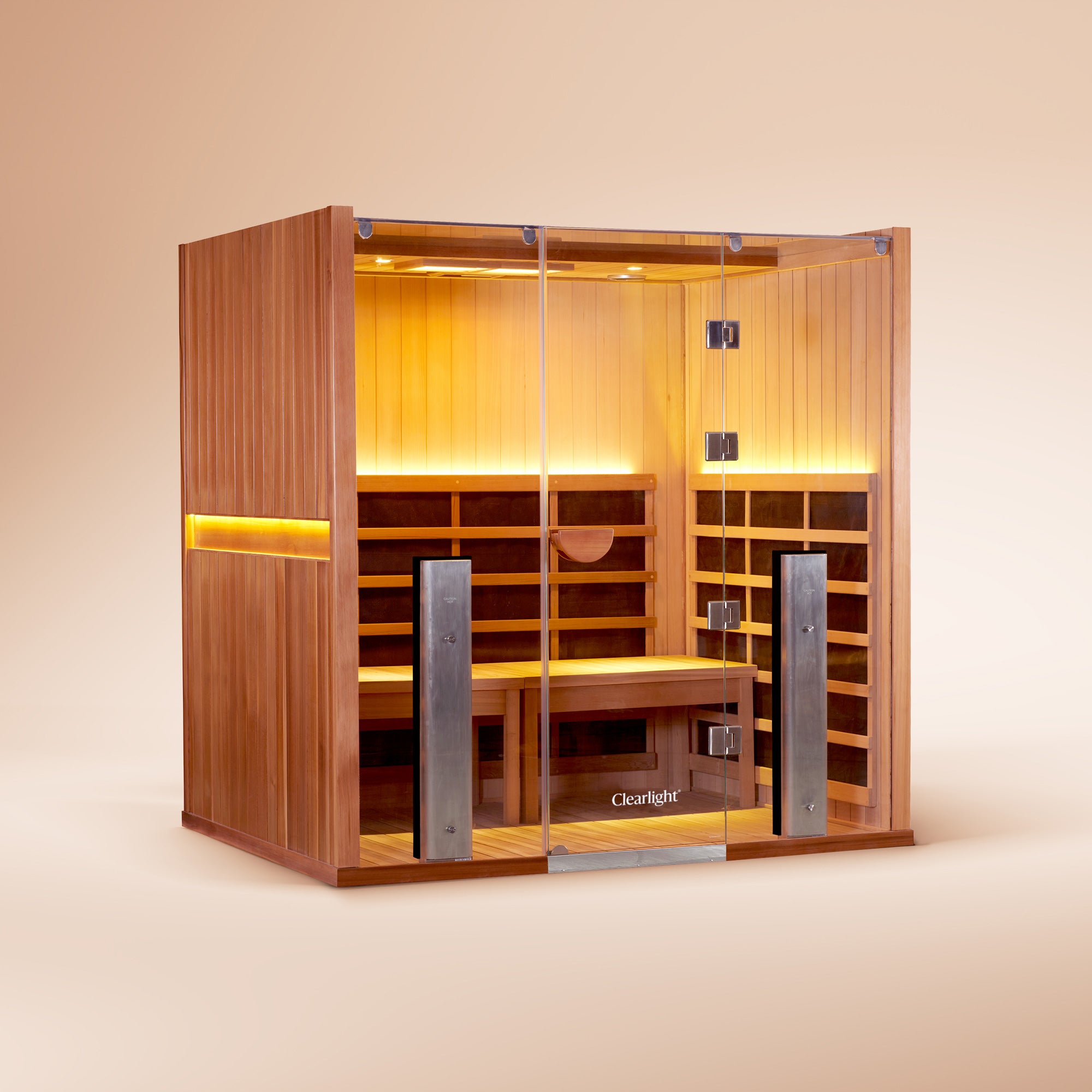Disclaimer: Clearlight® products are designed for general wellness purposes and are not intended to diagnose, treat, cure, or prevent any disease. Always consult your health professional for medical advice.
When comparing red light therapy and infrared saunas, it's essential to first understand some foundational principles of light. Both therapies use specific types of light on the electromagnetic spectrum, but their mechanisms and effects differ. By grasping these basics, it becomes much easier to appreciate the unique benefits of each therapy. Let’s begin by breaking down the different kinds of light involved in these treatments.
Is Infrared Light the Same as Red Light? Light Spectrum Basics
In physics, light is understood through the light spectrum. That light spectrum is part of the electromagnetic radiation spectrum (1; 2):

In the picture above, you only have to focus on three things:
-
The first type of light, UV light, is what potentially gives you sunburns and can also help create vitamin D in your skin (4; 5; 6). UV light exposure also gives you a nice tan. This UV light is invisible to the human eye.
-
The second type of light, visible light, consists of all the colours of the rainbow. Your eyes can see these colours, which is why this part of the light spectrum is called “visible light”. What many people don’t know is that all of the different parts of the visible light spectrum also affect their health (7; 8; 9; 10; 11; 12).
For instance, blue light can make you feel more awake, and yellow light can improve skin health and appearance. Now, red light also falls within this visible light spectrum. Red light therapy makes use of this part of the light spectrum, while infrared saunas do not.
- Thirdly, there’s infrared light (13; 14). Infrared light can be divided into “near-infrared”, “middle-infrared”, and “far-infrared light”. Just as different colours of visible light have unique health effects, different types of infrared light do as well.
Both red light therapy and infrared saunas use infrared light. Red light technology only uses near-infrared. Infrared saunas use far-infrared light, and if it’s a full-spectrum sauna, then middle and near-infrared light are also used.
Most types of infrared light generate heat when they come into contact with the skin. From a physics standpoint, heat and infrared light are closely connected. While a small portion of near-infrared light doesn’t produce heat, the majority of near-, mid-, and far-infrared light creates warmth. This heat effect is central to how infrared saunas work, using a combination of near, mid, and far-infrared light to promote deep relaxation and overall rejuvenation.
Now that the basics of infrared light are covered let’s dive into the specific benefits of red light sessions and infrared saunas.
Understanding Red Light Therapy and Its Benefits
A true “red light therapy revolution” has unfolded in recent years, thanks to the falling cost of LED light bulbs. Before 2010, red light therapy primarily used lasers, which were expensive and impractical for home use (15; 16). With the advent of affordable and safer LED technology, red light therapy has become widely accessible.
Again, red light therapy uses:
- The red portion of the visible light spectrum.
- A small, non-heating part of the near-infrared spectrum.
LEDs allow for precise control over the light wavelengths emitted, focusing specifically on the most beneficial ranges, like 660 nanometers, which is more effective than neighbouring wavelengths. Panels with multiple LEDs can direct a substantial amount of therapeutic light to the body.
Much like UV light impacts the body, red and near-infrared light penetrates deeply into tissues, influencing various biological processes (17; 18; 19; 20).
With nearly 6,000 studies exploring red light therapy's benefits (21), here are some key advantages:
- Enhancing sleep quality and promoting wakefulness in the morning.
- Boosting athletic performance and speeding up recovery after a session.
- Supports the body’s natural response to inflammation after exercise.
- Elevating your energy levels.
- Improved circulation and overall vitality.
Understanding Infrared Light Benefits
As we know by now, infrared saunas use far infrared as their basis. And if the infrared sauna uses full-spectrum infrared, middle and near-infrared lights are added to the mix. Like red light therapy, these infrared wavelengths penetrate the body deeply, triggering various biological responses that promote health and wellness.
Below is a brief overview of the many benefits infrared saunas provide:
- Faster muscle recovery for athletes.
- Improved blood circulation.
- Accelerated detoxification, removing toxins through intense sweating.
- Support weight-management goals as part of an active lifestyle.
- Healthier skin with improved elasticity and clarity.
- Reduction in stress and fatigue, promoting mental well-being.
- Helps you feel refreshed and supports youthful-looking skin.
For a comprehensive overview of the health benefits of infrared saunas, check out our dedicated blog.
Infrared saunas work differently than traditional saunas. Due to the infrared light, not only is the environment in the sauna heated, but your body as well. Unlike a regular sauna, infrared light heats your body mostly from the inside out. This deeper heat creates a more soothing experience and leads to more intense sweating compared to standard saunas.
Contrary to red light therapy, which doesn’t induce much sweating, infrared saunas promote heavy perspiration, supporting the body's natural detoxification process.

What Is the Difference Between Red Light Therapy And Infrared Sauna?
The primary differences between red light therapy and infrared saunas lie in the type of electromagnetic radiation they use, as well as their specific wellness focus and effects.
Red Light Therapy
Red light therapy uses visible red light and near-infrared wavelengths to stimulate skin and superficial tissues without producing significant heat. It enhances skin vitality, supports post-activity recovery, and promotes a refreshed, healthy appearance—making it ideal for targeted, non-heating treatments.
Infrared Sauna
Infrared saunas use far-infrared light to heat the body from within, raising core temperature to induce deep sweating. This supports detoxification, muscle relaxation, and improved circulation. It’s a full-body, heat-based therapy focused on overall wellness and recovery.
In summary:
-
Red light therapy = targeted, non-heating treatment for skin health and regeneration.
-
Infrared sauna = full-body, heat-based therapy for detox, relaxation, and circulation.
Red Light Therapy vs Infrared Sauna: Which One to Choose?
Although both red light therapy and infrared saunas provide significant health benefits, they function differently and target different aspects of wellness. When deciding which therapy is best for you, consider factors like your specific health goals, available space, and costs.
1. Key use cases of the heat
Red light therapy employs minimal heat, primarily targeting skin and superficial tissues. As a result, there’s no sweating involved, and any heat felt is mild and localised, usually when standing close to the light panel.
In contrast, infrared saunas are designed to maximise heat exposure, significantly raising core body temperature and promoting deep sweating. This full-body heat penetration makes infrared saunas particularly effective for detoxification through sweat.
If your goal is detoxification and enhanced circulation through sweating, an infrared sauna is the better choice. However, red light therapy may be more suitable for targeted skin care, promoting relaxation and supporting recovery after activity.
2. Ease of use
Both an infrared sauna and red light therapy are very easy to use. But, if you had to choose the option that’s easiest to use, red light therapy comes out on top. The reason is that with red light therapy, you can just press a button and start your session. As you know by now, there’s no sweating involved, so there’s also no cleaning up afterwards.
On the other hand, using an infrared sauna typically requires a bit more time and preparation. It’s recommended to pre-heat the sauna, which can take up to 15 minutes, and after each session, showering is advised to remove sweat and toxins from the skin. This post-session routine makes it less convenient for quick use compared to red light therapy.
So, while both offer significant benefits, if you're looking for the most effortless option, especially when time is limited, red light therapy is the ideal choice.
3. Space uptake
When it comes to space requirements, infrared saunas and red light therapy devices differ significantly.
For example, the size of a 1-person Sanctuary Full-Spectrum sauna is ~100cm by ~120cm by ~200cm (height). A 2-person or 5-person sauna will be much bigger than the 1-person option. This gives you an idea of the room needed for even the smallest sauna unit available.
On the other hand, red light therapy is much more compact. The AURORA Red Light Therapy Device is only ~22cm by ~2.5cm (thick) and has a height of ~70cm. As a very thin vertical unit, comparable to the space uptaken by a floor lamp, red light therapy is very space-efficient. For instance, you can store an AURORA device under your bed. Such an option might be advantageous if you live in a small condo or studio and don’t have room for even a 1-person sauna.
For those with restricted space, red light therapy is a more practical option, while infrared saunas require a dedicated area in your home.
4. Power consumption and electricity cost
The wattage draw of the red light therapy panel and infrared sauna is really different.
To give an example, the 1-Person Clearlight Infrared Sanctuary Full-Spectrum Sauna consumes 1,750 Watts (W), the 3-Person Clearlight Premier Far-Infrared model consumes 1,850W, and the 5-Person Outdoor Full-Spectrum Infrared Sauna consumes 3,800W.
A red light therapy unit such as the ARL Plus+ consumes 350W, instead. Also, the maximum session time for red light therapy is 20 minutes. An infrared sauna can be used for double that length, though.
So, if we compare the energy consumption per session, you consume 116W for a red light therapy session and 1,167W for a 40-minute session in the 1-Person Full-Spectrum Sauna. Infrared saunas thus consume about 10 times as much energy, although they’re still inexpensive for most people if you use them 5 times a week. For example, running a smaller 1-person sauna five times a week could cost approximately £50 per year. By comparison, a red light therapy panel’s annual energy cost would be well under £10, making it the more economical choice in terms of electricity consumption.
In short, red light therapy is the better option if you’re concerned about energy usage, but even infrared saunas remain relatively inexpensive to operate on a regular basis.

Can Red Light and Infrared Light Be Used at the Same Time?
Yes, red light and infrared light can be used at the same time. Both therapies complement each other well, as they target different body layers. Red light therapy focuses more on the surface, promoting skin health, collagen production, and enhancing the skin’s appearance, while infrared light penetrates deeper into tissues, supporting detoxification, muscle relaxation, and improved circulation. By using them together, you can simultaneously experience the benefits of both therapies, leading to enhanced overall wellness.
What Are the Benefits of Red Light Therapy in an Infrared Sauna?
The primary advantage of combining red light and an infrared sauna is the enhanced effect on skin health. This powerful combination promotes a refreshed look, supports skin vitality, and encourages overall skin wellness. By blending the soothing warmth of infrared heat with the targeted benefits of red light, you can achieve a more comprehensive approach to skincare and overall wellness.
Both therapies are powerful on their own—red light therapy offers targeted relief without heat, while infrared saunas provide a full-body detox and relaxation. However, using them together creates a synergistic effect, enhancing the benefits of each and boosting your wellness routine.
Check out our 3-Person Clearlight Sanctuary Full-Spectrum Sauna, offering the ultimate wellness experience by combining the powerful benefits of infrared heat therapy with the option to integrate red light therapy.











Can You Take AirPods Into A Sauna?
Using A Sauna For Erectile Dysfunction: A Promising Strategy